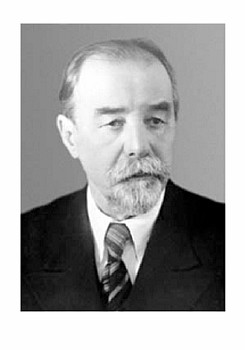|
- - - -
Gavriil Tikhov
Tikhov Gavriil Adrianovich (01.05.1875 – 25.01.1960)
Astronomer, astrophysicist, planetologist; founder of astrobotany
Gavriil Tikhov was born in Smolevichy, Minsk region. In 1893 he graduated from high school in the city of Simferopol, in 1897 – from Moscow State University. In 1898-1900 he continued his education at the University of Paris, worked at Meudon Observatory (France). In 1934 Tikhov received his doctorate in physics and mathematics, in 1949 - got the rank of professor. In 1906-1941 Tikhov was a member of the Central Astronomical Observatory of the USSR Academy of Sciences at Pulkovo. Simultaneously, in 1919-1931 he taught at Leningrad State University, in 1919-1949 he held the chair of astrophysics at Lesgaft Institute of Physical Education, which played a considerable part in the training of astrophysicists. From 1947 till the end of his life Tikhov was in charge of the Astrobotany branch at the Academy of Sciences of the Kazakh SSR.
His works include those on astrophysics, astrometry, photo- and colorimetry of planets and stars, atmospheric optics, aerial photography, astrobiology. In 1908 Tikhov discovered the effect of phase lag of eclipsing stars in the short-wave spectral region (the Nordmann-Tikhov effect). In 1909 he was the first to use colour filters in planetary observations and got the first pictures of Mars in various spectral regions. In 1914 Tikhov was the first in the world to ascertain that the Earth should appear bluish when observed from outer space, which was proved by the photographs made with spacecraft. Tikhov also proposed a method for rapid determination of the colour of stars (1915; a method of feathering spectrograph), he first estimated the color temperature of the solar corona (1936). Tikhov performed colorimetric investigation of Saturn, Uranus and Neptune. For over 40 years he was studying the physical nature of Mars, searching for evidence of vegetation existence on this planet. By comparative studies of the spectrophotometric properties of the Martian surface and terrestrial vegetation, Tikhov founded a new science - astrobotany (1945). He also designed a series of original photometric devices suitable for transportation. Tikhov is the author of the world's first monograph on aerophotometry (1917), and of the first textbook on astrophotometry in Russian (1922). In 1937 and 1951 he published catalogues of the colours of 17874 stars. In 1909 Tikhov won the Wilde prize of the Paris Academy of Sciences, and the Russian Astronomical Society award. In 1912 he was awarded the Medal of the French Astronomical Society. Tikhov was a corresponding member of the Academy of Sciences of the USSR (1927), an academician of the Academy of Sciences of the Kazakh SSR (1946), an honorary member of the American Astronomical Society (1946), and of the National Academy of Sciences of Belarus (1959), an honored science worker of the Kazakh SSR (1946). He died in Alma-Ata. There are craters on Mars and on the other side of the moon named after him.
Works:
1. Is Life Possible on Other Planets? // Journal of the British Astronomical Association. 1955. Vol. 65, No. 3. P. 193–194.
2. Основные труды. Т. 1–5. Алма-Ата: Изд-во Академии наук Казахской ССР, 1954–1960.
3. Principal Works. Astrobotany and Astrophysics, 1912–1957. U.S. Joint Publications Research Service, 1960.
Literature:
1. Kulikovsky P. G. Tikhov Gavril Adrianovich // Dictionary of Scientific Biography. Ed. Gillespie C. C. Vol. XIII. N.Y.: Scribner, 1976. P. 408–409.
2. Суслов А. К. Гавриил Андрианович Тихов, 1875–1960. Л.: Наука, 1980.

© National Academy of Sciences of Belarus, 2011
|
|


